Fermesand
Germany
Gauge : 600mm
Status : Working
In the area of Saterland in north west Germany, Union Torfwerk is one of several firms who use railways to transport peat
(Click on images for full size picture)
 Several of the peat railways in Germany feature roadside running, sometimes
for distances of several kilometers. Union Torfwerk is just one of several peat railways
in the area of Saterland, north of the Kusten Kanal in NW Germany. 3 to 4 of these railways
run alongside minor roads.There appears to be a fairly relaxed attitude in Germany to the proximity of these railways to road traffic, more so than would be the case in Britain!
Several of the peat railways in Germany feature roadside running, sometimes
for distances of several kilometers. Union Torfwerk is just one of several peat railways
in the area of Saterland, north of the Kusten Kanal in NW Germany. 3 to 4 of these railways
run alongside minor roads.There appears to be a fairly relaxed attitude in Germany to the proximity of these railways to road traffic, more so than would be the case in Britain!
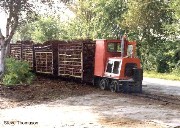 In 1993, one of the railway's several Schöma locos slowly hauls a loaded train back to
the processing plant, pausing briefly next to the railway works.
In 1993, one of the railway's several Schöma locos slowly hauls a loaded train back to
the processing plant, pausing briefly next to the railway works.
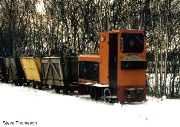 With a couple of inches of snow, the demarkation between the railway tracks and the road, is
easily lost, as two years later in March 1995, another Schöma is pictured pulling a train of empty wagons out to the peat moors. Several types of peat wagon are employed at this site, and here wooden splaysided wagons are in use.
With a couple of inches of snow, the demarkation between the railway tracks and the road, is
easily lost, as two years later in March 1995, another Schöma is pictured pulling a train of empty wagons out to the peat moors. Several types of peat wagon are employed at this site, and here wooden splaysided wagons are in use.
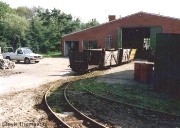 The small workshops for the railway are unusually situated about a third of the way
up the line along the roadside. Just a single loco was found inside, with many wagons
on and off the rails, scattered about awaiting repair.
The small workshops for the railway are unusually situated about a third of the way
up the line along the roadside. Just a single loco was found inside, with many wagons
on and off the rails, scattered about awaiting repair.
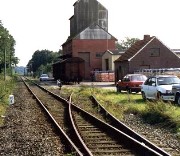 At the peat processing plant, the packing sheds are still served by a standard gauge
siding. Several other peat works in the area have now dispensed with rail distribution
and now rely solely on road transport.
At the peat processing plant, the packing sheds are still served by a standard gauge
siding. Several other peat works in the area have now dispensed with rail distribution
and now rely solely on road transport.
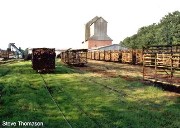 Around the other side of the plant, the narrow gauge tracks fan out into several
reception sidings where the loaded trains await emptying.
Around the other side of the plant, the narrow gauge tracks fan out into several
reception sidings where the loaded trains await emptying.
 Several types of peat wagon are in use, but the commonest is the typical cage wagon.
This is built onto an extended skip type chassis, and opens on both sides with a simple handle at at each end.
Several types of peat wagon are in use, but the commonest is the typical cage wagon.
This is built onto an extended skip type chassis, and opens on both sides with a simple handle at at each end.
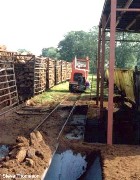 The tracks converge onto two sets of unloading hoppers. After the peat is dropped from each wagon, the empty freewheels down the gradient on the other side to form the next train out.
The tracks converge onto two sets of unloading hoppers. After the peat is dropped from each wagon, the empty freewheels down the gradient on the other side to form the next train out.